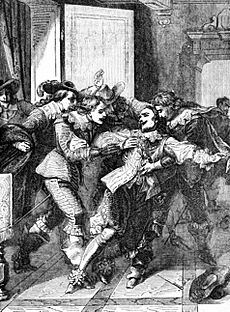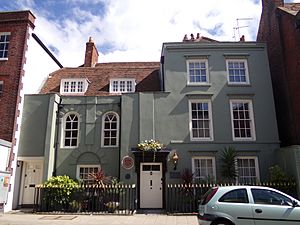John Felton (assassin) facts for kids
Quick facts for kids
John Felton
|
|
|---|---|

Felton in Prison, illustration from 'Cassell's illustrated history of England (1865)
|
|
| Born | c. 1595 possibly Suffolk, Kingdom of England
|
| Died | 29 November 1628 (aged 32–33) Tyburn, London, Kingdom of England
|
| Occupation | Soldier |
| Criminal status | Executed by hanging |
| Parent(s) |
|
| Conviction(s) | Assassination of the Duke of Buckingham |
| Criminal charge | Murder |
| Penalty | Death by hanging |
| Military career | |
| Allegiance | |
| Service/ |
English Army |
| Years of service | 1625–1627 |
| Rank | Lieutenant |
| Battles/wars | Anglo-Spanish War |
John Felton (born around 1595 – died 29 November 1628) was an English soldier. He is known for stabbing George Villiers, 1st Duke of Buckingham, to death. This happened in the Greyhound Pub in Portsmouth on 23 August 1628.
King Charles I trusted Buckingham very much. Buckingham became rich but failed badly in foreign affairs and military plans. King Charles put him in charge of a military trip against Spain in 1625. This trip was a complete disaster. Many soldiers died from sickness and hunger. Buckingham led another failed military trip in 1627. People in England hated Buckingham. His failures also badly hurt the king's reputation. Many people in England celebrated when Felton killed Buckingham, even after Felton was executed.
Contents
John Felton's Early Life
John Felton was born around 1595. He was likely born in Suffolk, England. His family was related to other Feltons from Playford. His father, Thomas Felton, had a job finding people who did not go to Anglican church services. His mother, Elanor, was the daughter of a former mayor of Durham.
His family's money problems began in 1602. That year, his father lost his good job. Thomas Felton died around 1611 while in prison for owing money. However, his mother later received some money from the crown each year.
Felton's Army Career
Not much is known about John Felton until the mid-1620s. At that time, he was an army officer. He served in the Cádiz Expedition in 1625. This was an attempt to capture the Spanish city of Cadiz. Buckingham supported this trip. It was a big loss for England. Many English soldiers and ships were lost.
Felton then served as a lieutenant in Ireland in 1626. His commanding officer died there. Felton tried to get that officer's job but did not succeed.
In 1627, Felton asked to become a captain. This was for Buckingham's military trip to Île de Ré. This trip was part of a war between England and France. The goal was to capture a French fort called Saint-Martin-de-Ré. This would help protect the city of La Rochelle. It would also encourage French Protestants, called Huguenots, to fight against the French king.
Felton had friends in important political groups. Even with their help, his first request to join the trip was turned down. Two months later, he became a lieutenant. He went with the second group of soldiers to Île de Ré in August 1627.
The trip was a disaster for the English. The soldiers did not have enough supplies. They also lacked the big cannons needed to attack the fort. Many soldiers were lost on 27 October. This happened during a final, desperate attack on the fort. The ladders they used were too short for the fort's walls. The English left soon after. They lost many soldiers during the campaign.
After returning to England, Felton lived in London for nine months. He did not stay with his family. People who met him said he was quiet and sad. His sister remembered that he had "dreams of fighting" after returning from Ré. This might have been a sign of what we now call post-traumatic stress disorder.
During this time, Felton asked important officials for help. He wanted £80 in back-pay he believed he was owed. He also felt he was unfairly denied a promotion to captain. He did not get what he wanted. He started to believe that the Duke of Buckingham was responsible for all his problems.
Killing the Duke of Buckingham
Buckingham was very unpopular in England. People were angry about England's defeat by the French. Even though the king, Charles I, helped him avoid legal trouble, Parliament wanted to punish him. By August 1628, Felton believed Buckingham was not only hurting him but also harming England. He decided to kill Buckingham. After saying goodbye to his family, he went to Portsmouth. Buckingham was there, planning a new military trip.
On the morning of Saturday, 23 August, Buckingham left his rooms. He was staying at the Greyhound Inn in Portsmouth. Felton managed to get through the crowd around Buckingham. He stabbed Buckingham in the chest with a dagger. Felton could have escaped in the confusion. But soon after, he showed himself to the crowd. He expected people to be happy and announced he was guilty. He was arrested right away and sent to London for questioning.
What Happened Next
The authorities thought Felton had help. They wanted him to name any other people involved. The Privy Council tried to make Felton talk by using a torture device called the rack. But the judges refused. They all said that using the rack was against the laws of England.
Many people liked what Felton did because the Duke was so unpopular. While Felton waited for his trial, people celebrated him in poems and writings. Copies of notes he carried in his hat were also shared widely. A poem by a scholar named Zouch Townley said that Felton had saved England and King Charles. Many copies of this poem were made. However, Townley had to flee to Holland after people found out he wrote it.
Other writings said that Buckingham was bad and weak. They said Felton was brave and good. The writer Owen Feltham called Felton a second Brutus.
The son of Alexander Gill the Elder was punished for celebrating Felton. He was heard saying good things about Felton and bad things about Buckingham. He was sentenced to a large fine and to have his ears removed. But these punishments were stopped after his father and Archbishop Laud asked King Charles I for help.
Felton was found guilty and hanged at Tyburn on 29 November 1628. The authorities made a mistake. They sent his body back to Portsmouth to be shown. They wanted it to be a warning. But instead, people honored it. This showed a big difference between how the public felt about Felton and how the authorities punished him.
A dagger said to be the one Felton used was shown until the 1800s. It was at Newnham Paddox in Warwickshire. This was the home of the Earls of Denbigh. Buckingham's sister, Susan, married the first Earl of Denbigh. This explains how they might have gotten the dagger.
Felton in Stories
The Three Musketeers
Felton's killing of the Duke is part of Alexandre Dumas, père's famous book The Three Musketeers (1844). It also appears in many movies based on the book.
In Dumas's book, Felton is a Puritan. He works for a made-up character, Lord de Winter. Lord de Winter asks Felton to guard Milady de Winter. She is a French spy. Milady's boss, Cardinal Richelieu, wants her to have Buckingham killed. This is so Buckingham won't help the Huguenots in La Rochelle. Milady tricks Felton into helping her. They escape together. Felton then stabs Buckingham. He says he did it because he didn't get promoted. This is to protect Milady. But Felton realizes Milady tricked him when she sails away without him. He is then hanged for his crime.
- In the 1961 French movie Les Trois Mousquetaires, Felton was played by Sacha Pitoëff.
- In the 1969 movie of the Three Musketeers, Felton is played by Christopher Walken.
- In the 1973 movie The Three Musketeers and its 1974 sequel The Four Musketeers, Felton is played by Michael Gothard. Felton appears briefly in the first movie. He is a Puritan servant of the Duke of Buckingham.
Other Works
Felton is the main character in a play by Edward Stirling. It is called John Felton; or the Man of the People. It was first performed in 1852.
The Duke's killing is also in Philippa Gregory's book Earthly Joys (1998). In Ronald Blythe's book The Assassin (2004), Felton is shown as a complex person. His reasons for the killing are shown as selfless.
See also
- List of assassinations



